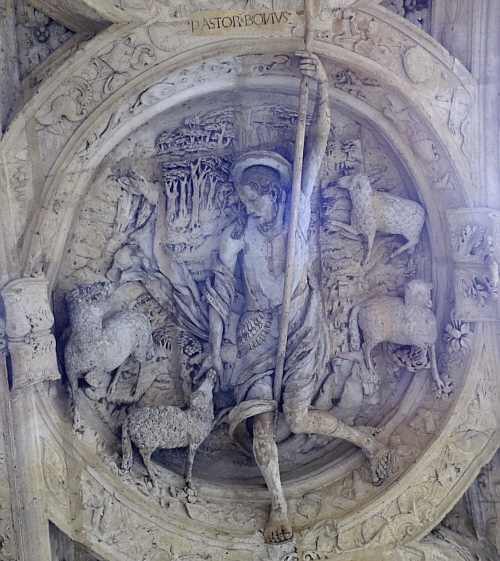In 2002, I wrote an email to a list saying, "Interestingly, the universal symbol of Christ in
churches prior to the 9th Century was Jesus as the Good Shepherd. After that Council's decision,
the universal symbol became Jesus crucified on the cross. Coincidence or deep truth?" I hoped to
generate some discussion about the subject, as I had no other information about it than what I had
read in a Rudolf Steiner lecture in which he expressed his perception of this change in the internal
appearance of churches around the 8th to 9th centuries.
When I visited Rome shortly afterward
encountering that passage by Steiner, I looked and found no evidence to support the claim in any of
the churches we visited because they were all post 9th Century churches or greatly modified since
their original construction. I was left with an unanswered question and given an opening on this
list, I thought it was a chance to open a discussion with knowledgeable parties on the topic.
My hopes were dashed when I received but one reply which blasted my broaching of the
subject, "It's really discouraging to see such an erroneous idea offered so confidently." It was really
discouraging to me to have this kind of response to a post to a list. No one else replied. It made me
wonder what kind of axe this person had to grind. There the matter lay until I found this book
about four months later in a catalog and decided to order it. It claimed to have images of Christ
throughout the two thousand years since his birth. Perhaps in here, I will find evidence one way or
the other to confirm this situation.
I am no expert on church art. I was merely passing on an idea I first encountered in Rudolf Steiner's
works about one of the visible results of a sea change in the church authorities around the 8/9th
centuries. I would imagine that the person who wrote this comment thought he was degrading me
personally not Rudolf Steiner, but I wonder if his ardor for the task might have increased if he had
known its source.
I do know a few things about Steiner and I have yet to find that his insights into what was
happening in the spiritual world at any age to be erroneous, even though he might be at odds with
certain historians with their own view of what really happened, their fable convenue. (See this review for a passage in which Steiner identifies the council as the Eighth Ecumenical Council of Constantinople in 869 A. D. and exactly what it said.)
As luck would have it, I was able to acquire an amazing book that was published to accompany an
exhibition at The National Gallery, London 26 Feb — 7 May 2000, called the Image of Christ.
Here's a few items of note from this book which is full of images of Christ over the two millennia
since his birth. The text [several authors for this museum piece] explains that since Christ Jesus
and his followers were Jewish, no images of him were made while he was alive and for centuries
later.
[page 9] Some hundreds of years later, Christianity had attracted many non-Jewish converts. Yet although the prohibition against images was relaxed, fear
of idolatry remained. The early Church had no cult images of Christ — nor did
Christians have churches, as we understand them, in which to place such
images.
[page 10] The instrument of Christ's victory, the cross, was seldom
represented; early Christians were reluctant to depict the gallows on which
common criminals were executed. In the catacombs, they showed the cross
covertly, for example in the crosspiece of a ship's anchor, emblem of hope (fig
3). Accompanying the anchor, or as a sign within an inscription, we find the oldest
symbol for Christ: the fish ( cat. No 4).
The first emblem or symbol was the Chi-Rho emblem — the X with the P stuck through the middle
that appears in many places in the Church. If you widen the top and bottom of the Chi or X, it
begins to look like a cross in some artworks. Chi-Rho represented the name "Christ" in the emblems and jewelry.
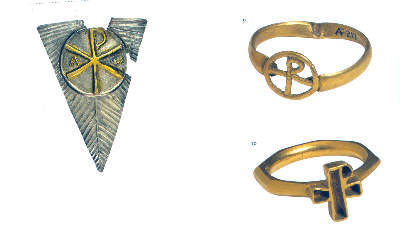
[page 10] Early Christian artists drew on secular tradition not only for
emblems such as the fish and the chi rho, but also when translating into visual
form the verbal imagery of the Bible, notably the metaphors of Christ as the
vine (JOHN 15:1, cat. No 20) and Christ the Good Shepherd (JOHN 10: 14-15;
27-28).
It's interesting to note that these early century Christians worked with visual symbols of
metaphors, and the Good Shepherd was among their favorite. Why?
[page 11] The early Christian Good Shepherd, who lays down his life for his
sheep, is indistinguishable, except by context, from shepherds in the idyllic
pictures of country life painted in Roman villas. He is young and beardless,
dressed in the short tunic of a farm labourer. He usually carries a sheep across
his shoulders, while other sheep stand trustingly by his side (cat. Nos. 1-3).
Now for the key point about the Good Shepherd:
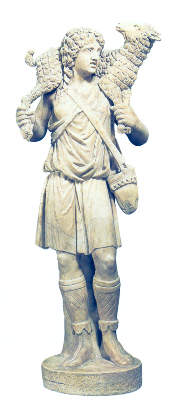
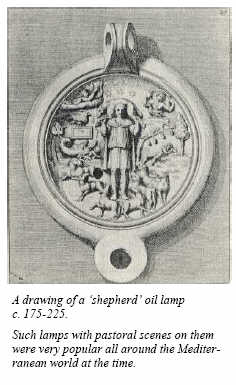
[page 12] Depictions of the Good Shepherd became common from the third
century AD, especially in the Roman catacombs, the ancient Christian
cemeteries outside the city of Rome, where they appear in wall paintings and
on sarcophagi and funerary slabs. The Good Shepherd images should not be
understood as representations of the person of Christ but as visual renditions
of the metaphor employed by him to cast light on his nature and mission.
To my way of thinking a "visual rendition of a metaphor" is a visual rendition of a prevailing
spiritual feeling that pervades the lives of the people who create the metaphor and it was this point
to which I imagine Steiner directed his comment about the Good Shepherd. The National Gallery
of London and its sources seem to agree with Dr. Steiner on this point. The book shows color
plates of two Good Shepherd statues. The statues were renditions of the metaphor of the Good
Shepherd, not Christ Jesus as a man — such a direct attempt to portray the Christ apparently did
not occur to these early Christians.
They did not focus on Jesus the man crucified on the cross like a common criminal so they did not
make images of that aspect of his life in the 3 and 4th centuries. To them the cross as a common
instrument of execution was as much an abomination as the electric chair to many today.
After Constantine won his battle as promised by Christ in a vision, he stopped persecuting
Christians and the CHI RHO began to appear on his coins and his military banner, not as a cross
but as an emblem of CH-Rist. It is easily mistaken as representing a cross, but it does so only
coincidentally due to the X shape of the letter CHI. In some emblems the letter alpha appears in the
left opening of the X and omega in the right side, but in others such as on page 22, the shape is
more that of a P with a horizontal bar through it — looking ever so much like a cross, but really is
the Chi Rho with the X filled in.
This trend continues into the 5th and 6th centuries.
This next passage from the text reveals the sea change which began in early 8th Century, 692 to be
exact:
[page 36] In early Christian sculpture and mosaics, Christ was frequently
represented as a lamb. In later times there was a reaction against this kind of
symbolic animal imagery and a Church Council held under Justinian II in
Constantinople in AD 692 decreed that in future Christ should be represented
only in human form, since 'the painter must, as it were, lead us by the hand to
the remembrance of Jesus, living in the flesh, suffering and dying for our
salvation and thus obtaining the redemption of the world.'
I will remind you that I specifically pointed to Christ on a crucifix as the emblem which began to
first appear in Churches of the 8/9th centuries, not the cross per se. The cross was used as an
emblem and the text deals with that on pages 38, 39. Note that the following contains the verbatim
text — the parenthetical material is in the National Gallery text:
[page 38] The earliest evidence for the use of the cross to symbolise Christ (but
not the crucifix, which appears later) dates from before the end of the first
century AD.
As I read through the rest of the book and checked images with dates, no images appear of Christ
crucified on a cross before the San Clemente of Rome image of the 12th century.
From further research, I located with the help of a friend an image from a door panel whose dating is uncertain, varying from 5th to 12th century, on Santa Sabina's Basilica in Rome.
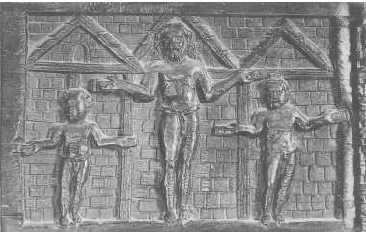 The above image was found on this site with this comment about the door panel and age of the door:
The above image was found on this site with this comment about the door panel and age of the door:
One of the reasons for a later dating of the door, up to the twelfth century, has to do with one of the finest panels of the Biblical History. That panel (pictured below) is found on the top course at the left edge. It is a crucifixion scene. Here Jesus is pictured hanging between the two thieves, though on a larger scale. His head is lifted and turned slightly to His right, His eyes are open and fix on the beholder.
This is not a closed investigation, just a preliminary foray to which I expect to add more notes as I
do further research. I hope these notes have shed some light for others on the point that I attempted
to make with my question, "Coincidence or deep truth?" I would say that the answer to my
question is definitely "a deep truth" — where what I mean by deep is "something that brings light
from the spiritual world".
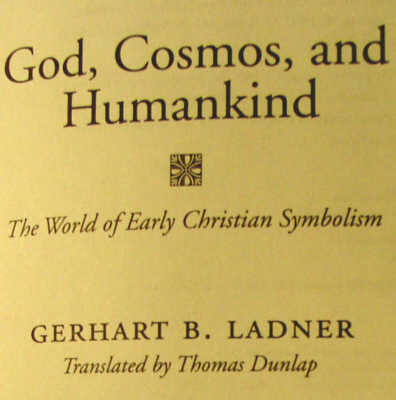
At the recommendation of a friend, I investigated the book God, Cosmos, and Humankind by Gerhart B. Ladner, 1995 which is filled with photos of early Christian churches, and other artifacts. What I found supported the thesis that few if any images of Christ Jesus decorating churches appeared as a man suffering on a crucifix before the 8th Century. Below are some thumbnail size samples of photos from the book with descriptions of their location and time of creation. I found this statement in the book which reveals a projection of present day understanding of the cross unto to the earliest Christians — it represents an opinion that, rightly understood, does not fit with the photos of artifacts created before the 8/9 centuries that are shown in the book.
[page 20] To all Christians, the cross was the symbol, the archetype and model, of self-renunciation and the readiness to suffer for God and humankind, even to give up one's life.
Instead of models of suffering of a man on a cross, we found that, prior to the 8/9 centuries, three themes appeared (in addition to the Chi-Rho theme mentioned above): the Cosmic Cross (some with the head of Christ as an emblem in the middle), the Good Shepherd (earliest form of symbol of Christ), and the Cross combined with the Tree of Life. These are shown first below:
Cosmic Crosses
From Apse Mosaic of Classe near Ravenna 549 AD (left) From Santa Pudenziana, Rome, early 5th Century AD (right)
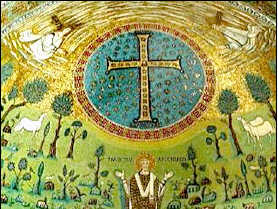
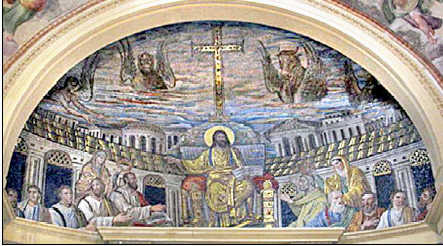
Good Shepherd
Rome, Coemeterium Mauis, c.4th Century
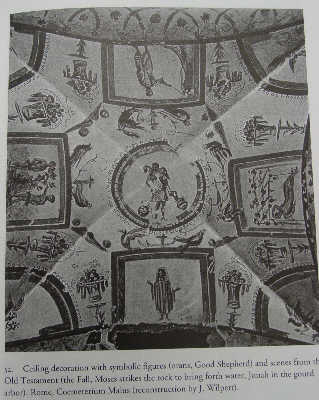
Cross with Tree of Life
With emblem of Christ's head above cross, 6th Century (left) From Dome Mosaic Venice, San Marco (right)
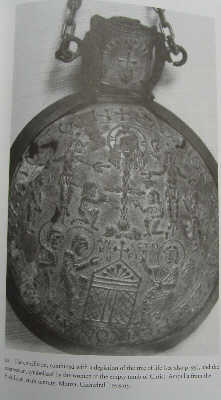
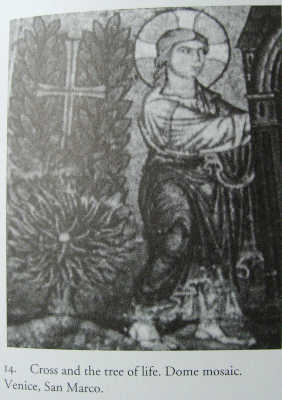
Representations of Christ Crucified on the Cross
Here are the examples we found which clearly showed Christ on a Crucifix. All were 8th Century or later images, except one illustration in a Gospel book. One was on a reliquary box. One a wall painting. The third was the illustration in a book of the Gospels — note that this item, from a book of the Gospels, is the only one prior to 8th Century which shows Christ Crucified. This is a book, not a Church decoration.
Left: Reliquary Box with Christological scenes, Vatican Museo Sacro, 7/8th Century AD
Middle: Wall painting of Crucified Christ, Rome, Santa Maria Antigua, 8th Century AD
Right: Rabbula Gospel Book from Syria, Florence, Biblioteca Laurenziana, 586 AD
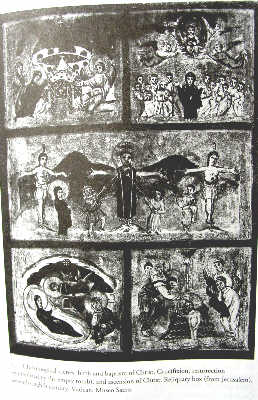
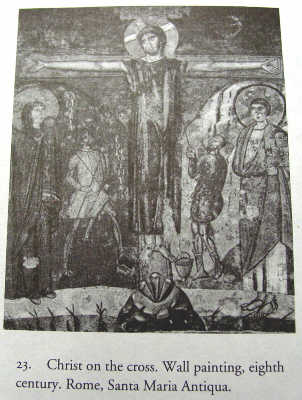
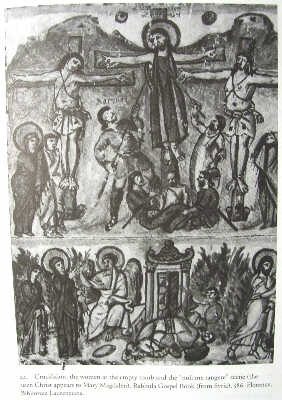
~^~
Any questions about this review, Contact: Bobby Matherne
~~~~~~~~~~~~~~~~~~~~~~~~~~~~~~~~~~~~~~~~~~~~~~~~~~~~~~~~~~

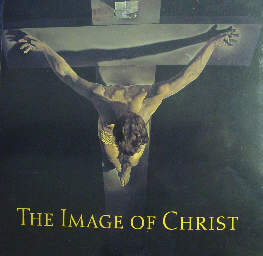 == == == == == == == == == == == == == == == ==
== == == == == == == == == == == == == == == ==
22+ Million Good Readers have Liked Us
22,454,155
as of November 7, 2019
Mo-to-Date Daily Ave 5,528
Readers
For Monthly DIGESTWORLD Email Reminder:
Subscribe! You'll Like Us, Too!
== == == == == == == == == == == == == == == ==
Click Left Photo for List of All ARJ2 Reviews Click Right Bookcover for Next Review in List
Did you Enjoy this Webpage?
Subscribe to the Good Mountain Press Digest: Click Here!


CLICK ON FLAGS TO OPEN OUR FIRST-AID KIT.
All the tools you need for a simple Speed Trace IN ONE PLACE. Do you feel like you're swimming against a strong current in your life? Are you fearful? Are you seeing red? Very angry? Anxious? Feel down or upset by everyday occurrences? Plagued by chronic discomforts like migraine headaches? Have seasickness on cruises? Have butterflies when you get up to speak? Learn to use this simple 21st Century memory technique. Remove these unwanted physical body states, and even more, without surgery, drugs, or psychotherapy, and best of all: without charge to you.
Simply CLICK AND OPEN the
FIRST-AID KIT.

Counselor? Visit the Counselor's Corner for Suggestions on Incorporating Doyletics in Your Work.

All material on this webpage Copyright 2019 by Bobby Matherne


